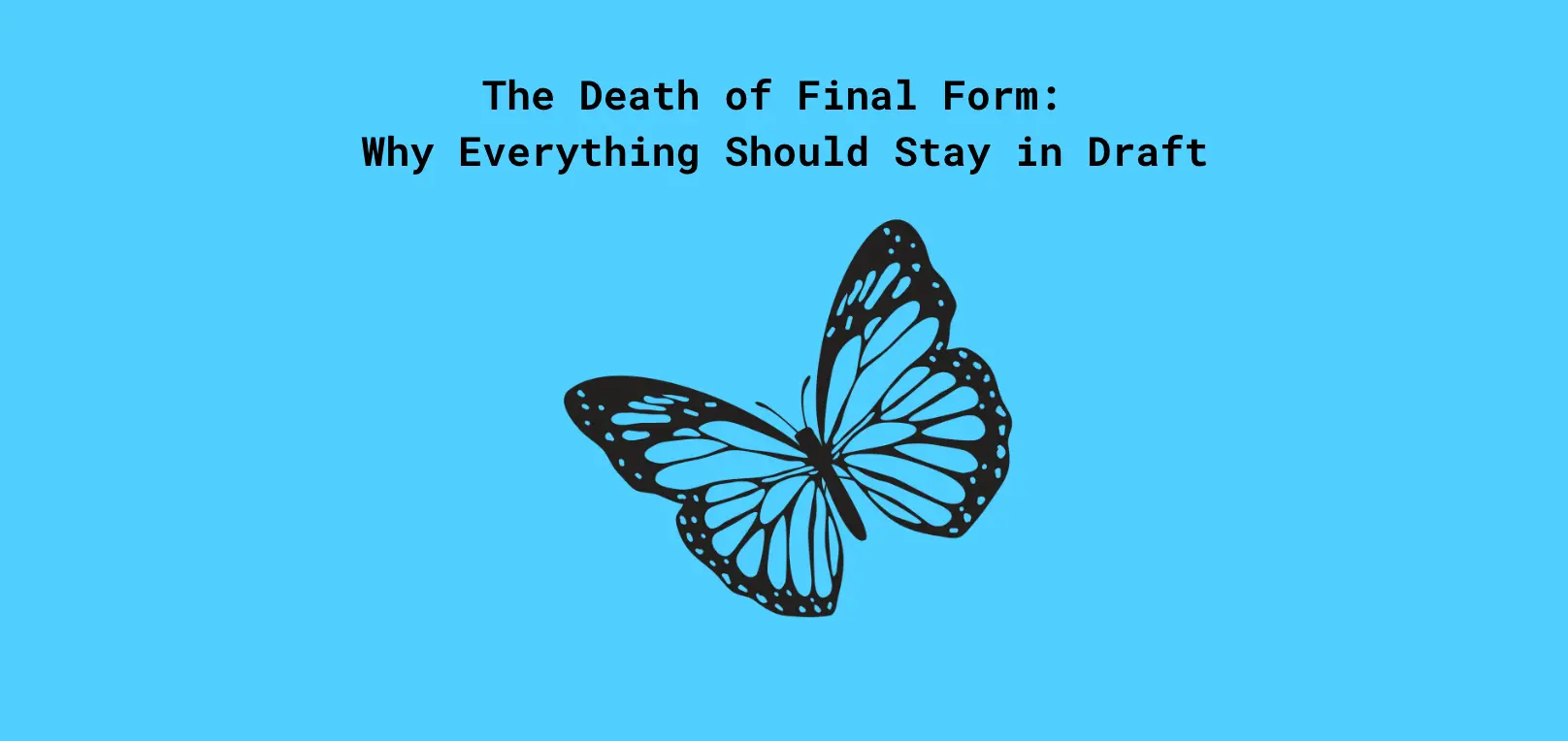
The Death of Final Form - Why Everything Should Stay in Draft
{frontmatter.title}
At some point, we've all grumbled about documentation. It's never fun to write, rarely appreciated, mentally draining, and inevitably out of date the moment you hit save.
If that sounds familiar, maybe we're thinking about it all wrong.
The problem isn't documentation itself. Rather, it's our obsession with creating a "final form." When you write something intended to be complete and perfect, you've essentially signed an invisible contract: a commitment to maintain this artifact indefinitely. Instead of being a tool that propels you forward, it becomes a burden that drags behind you.
And when you inevitably don't maintain it? Someone will come knocking, breaking your flow and derailing whatever you're currently focused on.
The Snapshot Problem
The "final form" never captures your evolving thinking. At best, it's a snapshot of what was correct at a specific moment in time, containing only the bits you remembered to write down. Even the most detail-oriented among us miss things, forget context, or fail to anticipate future needs.
Here's the uncomfortable truth: the most populated piece of documentation is actually your notebook - physical, digital, or that chaotic mess you call a knowledge management system.
So what's the alternative?
Embrace the Draft Mindset
I'm not suggesting we never share information. Quite the contrary! What I'm advocating for is a shift in our documentation philosophy: everything should stay in "draft" condition.
By "draft," I don't mean sloppy or incomplete. I mean raw, honest, and expansive. Like a brain dump or a voice message you'd send to a trusted collaborator. Not meticulously curated, but rich with insights captured at the moment of discovery.
The goal becomes getting your thoughts into this draft state: fast, unfiltered, and without the pressure of creating something "final."
This approach acknowledges a fundamental truth: most people don't read documentation until they hit a problem or need to accomplish something specific. With traditional "final form" documentation, you're essentially maintaining something that may never be needed, or at least not in a way you can anticipate.
No wonder it feels like a soul-crushing chore nobody wants to do. We'd all rather build than write about what we're building.
The Discomfort Zone
There's genuine discomfort in sharing drafts. We worry that exposing our raw thoughts will make us look stupid or incoherent. This is perfectly normal. Just look at artists who refuse to show their paintings or music until they deem them perfect, sometimes not even then.
Perfection doesn't exist, yet we all strive for it, even in something as mundane as documentation.
But what if this perfection-seeking is actually counterproductive?
Redefining Documentation for the AI Era
With AI, there are obvious benefits to the draft approach. An AI can potentially:
-
Clarify your thoughts: Turn your stream of consciousness into something more structured without you having to do the heavy lifting
-
Remember what you were thinking: Store and retrieve context that would otherwise be lost to time
-
Feed your updated thoughts into new resources: Evolve documentation alongside your understanding
-
Connect different drafts from different people: Find patterns and insights across an organization's collective thinking
Let me give you a real-world example. When I'm working on a complex problem, I often:
- Blast 10-15 quick notes with screenshots, links, or code snippets
- Ask an AI to summarize these notes
- Have it tell me which notes seem most relevant to my current task
- Based on these notes, get suggestions on where I should focus next
If I discover a note isn't relevant, I can always generate a new summary. The key is that everything is logged, so if I need it in the future, the AI will remember.
From Personal to Organizational Knowledge
The draft approach becomes even more powerful when expanded beyond the individual. Imagine a team where:
- Everyone captures their thinking in draft form
- An AI connects related drafts across the organization
- When someone faces a problem, the AI surfaces relevant drafts from colleagues
- Knowledge flows organically without forced documentation tasks
The documentation becomes living, breathing, and most importantly, useful at the moment it's needed.
The Future of Working with Drafts
As AI continues to evolve, the benefits of the draft approach will only multiply:
-
Automatic context sharing: AI could identify when you're working on something related to a colleague's drafts and proactively offer insights
-
Cross-tool integration: Your drafts in one tool could inform your work in another without manual effort
-
Temporal intelligence: Understanding not just what was documented, but also when and why, creating a richer context
-
Draft-to-presentation: Transforming your raw notes into polished materials for specific audiences on demand
-
Memory extensions: Acting as both short-term working memory and long-term organizational knowledge
Moving Beyond the Final Form
The irony is that by embracing drafts, we might actually create better "final" documentation when we really need it. By capturing our thinking continuously in raw form, we accumulate the ingredients for something more comprehensive than we could create in a single documentation session.
In fact, new "final forms" can be generated on-demand when somebody needs it.
When documentation isn't an event but a natural byproduct of how we work, it becomes both less burdensome and more valuable.
So where do we go from here? How do we get comfortable with leaving things in draft form?
Start small. Next time you solve a problem, instead of trying to create the perfect write-up, just capture your thinking as it happens. Share those raw notes with a trusted colleague. Notice how much more useful and how much less painful the process becomes.
The age of the final form is ending. The era of the perpetual draft is just beginning. And our knowledge work will be better for it.
Agree/Disagree? Chat me up on LinkedIn, either via DMs, or directly on the feed 🫶